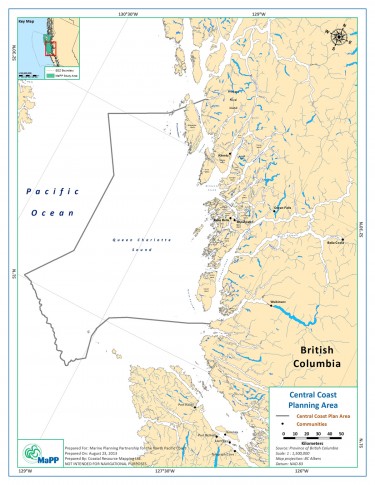Quick Links to the Central Coast Marine Plan, Marine Plan Overview and Annual Reports
- Central Coast Marine Plan
- Central Coast Marine Plan Overview
- Central Coast Annual Report 2021-2022
- Central Coast Annual Report 2019-2020
- Central Coast Annual Report 2018-2019
- Central Coast Annual Report 2017-2018
- Central Coast Annual Report 2016-2017
Hundreds of islands, exposed rocky headlands, nearshore kelp forests and the shelf waters of Queen Charlotte Sound characterize the Central Coast’s marine and coastal areas. The exposed outer coast meets an intricate shoreline, cut by narrow channels and steep-walled fjords, that provides ecologically complex estuaries, calm inlets and pocket coves.
A rich diversity of marine life thrives in the habitats of the Central Coast’s nearshore and offshore waters. Kelp forests and eelgrass beds support invertebrate and fish communities including herring, eulachon, salmon, crab, prawn, and numerous rockfish species. Some of the most abundant salmon runs on the coast support a rich food web that includes killer whales, seabirds, spirit bears, grizzly bears and wolves. Globally significant populations of marine birds rely on the rich marine feeding grounds of the Central Coast, and numerous marine mammal species are sighted on a regular basis throughout the region. The adjacent terrestrial area has become well-known as the Great Bear Rainforest. Many terrestrial animals forage extensively in the intertidal zone and create a vital link between marine and terrestrial ecosystems.
The plan area includes the traditional territories of the Heiltsuk, Kitasoo/Xai’Xais, Nuxalk and Wuikinuxv First Nations. Central Coast First Nations’ culture relies on a close connection with the ocean for spiritual, economic and food-source sustenance. Management and use of abundant marine resources, particularly salmon, supported ancient civilizations and allowed rich and complex cultures and societies to develop. Archaeologists have dated the origins of village sites on the Central Coast as far back as 11,000 years – making them some of the oldest continually occupied sites in Canada.
Approximately 3,500 people live in the plan area. Bella Coola, Bella Bella, Ocean Falls, Wuikinuxv, Shearwater and Klemtu are the main communities. The Central Coast communities depended primarily on logging and fishing industries in the recent past. While these industries are still critical, the local economies are becoming more diversified with a recent focus on aquaculture, tourism and other service sectors.








